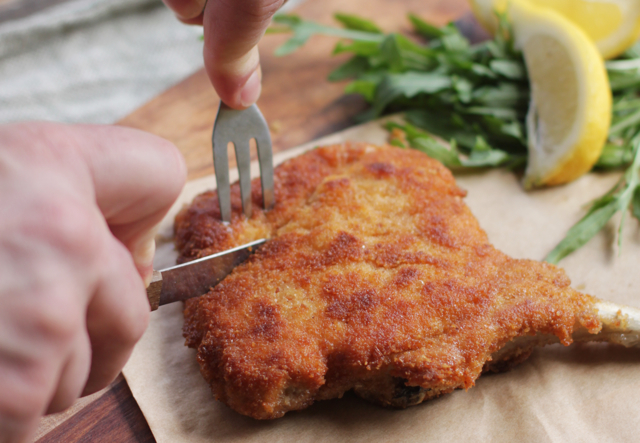This is one of those dishes that make a regular appearance on our table at home. It’s simple, it’s crunchy, it’s meaty and always satisfying. But while simple, there is somewhat of an art to getting this golden, breaded veal chop perfectly crisp outside and moist inside. All the credit to cooking and testing countless recipes, I have to say, goes to my husband Marco, who is obsessed with getting the most incredibly crisp breadcrumb coating possible. I first shared this recipe with his tried and true method for the perfect, traditional cotoletta alla milanese on my Regional Italian Food column that I write weekly for Food52. But it is too good not to share here too.

The cotoletta alla milanese is a classic of Milan’s cuisine, up there with saffron-stained risotto, osso buco and panettone. It gets its name from the cut of meat traditionally used, la costoletta, an inch-thick bone-in veal chop, which would correspond to a prime rib cut, such as rib eye. A second version of the cotoletta is made with a beaten-out-till-enormous-but-thin cutlet of veal, aptly called l’orecchia di elefante (elephant’s ear), as reference to its size and shape. It’s for those who like their fried goods crunchy all the way.
The Milanese can get a little defensive if you happen to suggest that their cotoletta is comparable to Vienna’s weiner schnitzel, and will proudly point out that their cotoletta has been a specialty of the Lombardy region since the twelfth century. Recorded in documents from 1134, a meal of lombos cum panitio (breadcrumbed rib chops) was one of nine courses for the festival of San Satiro. It’s mentioned again in 1492 in a recipe in Maestro Martino da Como’s famous manuscript. The dish was even transported to Argentina where it became adapted to local tastes and is known as milanesa, a homage to its city of origin.

Essentially, a veal chop is passed through beaten egg, then breadcrumbs and the chop is fried in a shamelessly large amount of clarified butter until crisp. It’s easy to make and good results are achieved when following these few golden rules:
- Although traditionally cotoletta alla milanese is made with just egg and breadcrumbs, passing it through flour before the egg helps to keep on the breadcrumb coating.
- Don’t salt the meat or put it in the coating as it will lead to the breadcrumbs falling off. Season at the end, preferably with nice, flaky salt.
- Leaving the breadcrumbed chop to rest in the fridge for at least thirty minutes before frying will result in a crisper coating.
- Use clarified butter. It’s really easy to make – see this post by David Lebovitz for a good recipe.
- Pan fry on medium heat. Too cool will result in a soggy breadcrumb coating and too hot will burn. If you notice your pan getting too hot, adding some cold butter is a good way to even out the temperature quickly.
- As soon as you put the chop in the pan, do not touch it until it’s ready to turn. One turn only. Messing about with it while cooking can ruin the coating.

Cotoletta alla Milanese
Breaded veal chops, Milan style
Cotoletta is usually served with a lemon wedge to cut the fried-in-butter goodness, but after all that work to get the perfectly golden, crisp breadcrumb coating, some may think it’s a bit counterproductive as it immediately turns your work soggy. Better would be to serve it with a glass of wine — a sparkling Franciacorta would do the trick. Also, while veal is the classic – this same method of breadcrumb coating is great with pork chops or chicken too.
For 4 people
- 4 veal chops, such as bone-in rib eye
- flour
- 2 eggs
- 1 ½ cups breadcrumbs
- 1 cup clarified butter
- pinch of salt
Pat the veal chops well with kitchen paper so they are as dry as possible and set aside while preparing the coating. In a shallow bowl, crack the eggs and beat. In another bowl, place the breadcrumbs.
Dust the chops first with flour, then dip in the beaten egg, letting any excess egg drip off before placing in the breadcrumbs to coat entirely. Pat down the breadcrumbs well.
Place the clarified butter in a skillet over medium heat. When the butter begins turning a caramel colour, place the chops in the butter and fry until golden brown. Turn, the chops, and continue frying until cooked through, about 6-8 minutes per side. You may need to cook just two chops at a time; if doing this, use half the butter for every pair of chops.
Remove from the pan and place on a wire rack to rest the meat. You may want to place it somewhere to keep warm, such as in a low oven (or an oven that was heated and then turned off), but do not cover it or place it directly on a plate as it will become soggy. Season with salt and serve warm with a wedge of lemon (if you’re going that way) or a glass of wine.




Comments
Oh that looks so so good, so simple and so scrumptious.
I wish I could have one of those right now! But I fear the meat wouldn’t be defrosted in time for dinner! Next time. Ah you’re so lucky your man cooks!
I am super lucky – I always say, without him I wouldn’t be able to keep up this blog!
I love the simple goodness of this classic dish. Like a lot of things, it’s the attention to detail that separate great cooking from the merely good, so all your thoughtful tips are especially welcome!
PS: I’ve read claims that the Austrians actually got the Schnitzel from the Milanese. Not sure how much evidence is behind it, but given how old the cotoletta is, it seems credible.
Emiko, that second photo had my belly hammering inside me! I simply wished I could reach in grab, forget the cutlery; a glass of white in my left and cotoletta in the other and I think I could go skipping away happily. 🙂
I am more partial to the orecchia d’elefante, but I have to say that these cotolette look absolutely incredible… super crispy yet juicy… BIG mistake to look at them a whole hour before my lunch break!
We are making these this weekend to your recipe – appreciate the wine suggestion! Hopefully they turn out as good as yours look! x
Hooray! Hope it all went down well 😉
I`ve cooked this last night after running across your recipe and it was absolutely brilliant! I`ve had the cotoletta when going to Italy last year and tried to picture the cooking process in my mind while eating it (I sometimes do that when I get by a good dish) but couldn`t figure it out entirely. I`m proud to say that mine tasted the same as original 🙂 . Two thumbs up! Loved the thoroughness of your indications. It`s the small things that are game changers.
Best of luck!
Love this recipe, but do you think I can substitute the chops with chicken cutlets sliced thin? If so do I have to change anything in the procedure. I too lived in southern Italy for 11 years and don’t remember ever eating anything like this. Just the standard cutlet that you soak for a bit in the egg then you bread it and fry it in olive oil. Very delish as well. And a really good start to an excellent chicken parm!! Thank you I’m glad I came across your web site, it looks fresh and clean.
Absolutely! If they are thin, they won’t take as long to cook but otherwise it’s very similar!